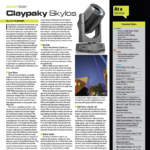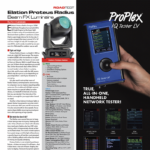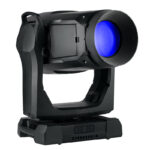The light offers two power modes for the lamp, Standard and Studio. In Studio mode, the lamp is throttled back to 1200 watts, and the cooling system ramps down accordingly for sound-sensitive applications. This also reduces the lumen output a bit.
 The Optical Path
The Optical Path
Immediately after the lamp are the strobe flags, which are simple black and silver flags. These are mainly for strobing and shutter effects, but they also close when the dimmer is at 0 percent to protect the glass from heat and prevent light leaks.
Next in the optical path is the dimmer, which is a two flag system that has a gradual pattern slowly fading from clear to black. The VL4000 BeamWash has a dimmer curve, which is very steep on the top end, and Philips Vari-Lite tells me this curve was chosen to match the performance of the VL3000 Spot and to ensure consistency across dim operations. Personally, I prefer curves slightly closer to a linear or square law, or having user-selectable dimmer paths via a menu system. The dimming, overall, is very smooth and very fast.
Also on this module is the color-mix system which, like the VL4000 Spot, uses four dichroic glass filters that run back and forth on tracks. These move very fast and do very nice color bumps and effects. Mounted at the top of this module is a glass homogenizing filter, which helps smooth out aberrations in the system. It does not completely remove them, however, as I saw some distinct uneven coloration in the beam, particularly when mixing yellows with cyans in beam mode. Other half-mixed colors were better, and the uneven edges are completely invisible with the wash optic inserted. All color-mix systems are a trade-off between speed, evenness and saturation, and this one is no different. There is also a CTO filter that adjusts the color temperature down to a pleasing incandescent hue and provides excellent skin tones.
Beyond this are two fixed color wheels, each with five colors plus open. These are a very good complement to the mix system, helping to fill in the gaps and provide colors that are difficult to mix with this system, particularly red and two shades of green, a Kelly green and a bright primary green, which I really appreciate. Split colors work very well with this system; the gaps between the filters are almost invisible. Interestingly, the wheels are positioned so that their axes coming into the beam are offset 90º from each other, so that overlying split colors results in a four-colored beam with four pie-shaped wedges of color. The wheels all utilize a shortest-path algorithm by default and are user-replaceable. There is also a color control channel for each wheel, which lets you change the path algorithm and do variable-speed spins and wheel shakes.
Next in the line are the gobos — seven rotating and indexing gobos plus open on each wheel. The patterns are primarily optimized for aerial effects, with an ample selection of gobos for beams. All the gobos are glass and use the familiar carrier system with a replaceable glass gobo in a holder. I noticed that Philips Vari-Lite added a small white arrow to the gobo wheel and holders to aid in aligning the gobos across fixtures — a feature that anybody who has to install gobos into multiple fixtures will appreciate! It’s impossible to get perfect focus on a gobo, and there is significant center-to-edge difference in the focus, though it’s better at narrow zoom positions than wide. This is expected from a combination wash and effects light like this ,and is not objectionable. There’s also an iris to reduce the beam angle down even further than the zoom. The VL4000 BeamWash ships with a animation wheel with a dots pattern by default, but Philips Vari-Lite offers different patterns to choose from. They also provide a mode on all the gobos and prisms referred to as “Mega Stepping,” which emulates choppy eight-bit movement on wheel rotation, an interesting effect.
Zoom and Focus
Next in line is the zoom and focus lens group, which requires a bit of discussion. The VL4000 BeamWash has three modes, selectable via DMX, which control the beam characteristics of the light. In “Wash” mode, a large “orange peel” textured filter drops in front of the lenses, right before final output, to homogenize the beam and spread the angle. In “Beam” mode, this filter is taken out, for use with gobos and the two prisms. In “Shaft” mode, the zoom element locks at its narrowest range and stays there, focusing all the power of the light down a 4º beam that looks as though it could knock you down if it hit you. You can further reduce the angle of this beam using the iris, creating a powerful pencil-thin beam. The zoom is reasonably fast, covering its 4º to 40º range in just around .5 seconds.
There are also two prisms near the lens groups. The prism arm gets inserted between different sets of lenses, depending on the zoom. When the zoom changes, the prism arm may need to remove itself from the beam, allow the appropriate lenses to move past it, then re-insert itself. The whole process only takes about 1 second to complete, but it is very noticeable. It’s possible to keep the prisms in location (while limiting the zoom range) via DMX to prevent this from happening. The prisms included are a five-facet linear prism, and what the company calls a “Lenticular” effect, which essentially “stretches” the output shape — including any gobos — to be very long. Rotating this produces interesting, almost 3D effects with gobos. The linear prism provides good image separation and reasonable fall-off toward the edges.
Pan and Tilt
Full-range pan and tilt times take around 6.2 and 4.2 seconds, respectively. These motors are throwing around a lot of glass, so this isn’t unexpected. Movement is very smooth, with no steppiness noticeable anywhere, and repeatability is excellent. Resetting takes a fairly long 1:30, and is non-distracting, snapping to black, resetting, and then snapping back to a look. The VL4000 BeamWash has a full-color, battery-powered display, which allows addressing and setting modes without powering the fixture.
The unit accepts power input power from 200-240VAC via Neutrik PowerCON TRUE1 connectors, which I’m very happy to see being adopted by the industry. It also has a USB port on the front panel for software uploads, and a single fixture can update others in the rig over DMX. Like the VL4000 Spot, the mounting brackets can be put on in diagonal orientations around the perimeter of the base instead of only at 90º increments.
At a Glance
Plenty of Features and Lumens
The VL4000 BeamWash is a versatile light with a great set of features and enough lumens to satisfy even the most brightness-obsessed among us, and its quality construction and array of effects make it a formidable addition to the large-format washlight market. Combines beam functionality with the ability to produce a powerful collimated shaft of light.
Vari*Lite VL4000 BeamWash
PROS: Very bright, fulfills multiple roles within a rig
CONS: Unusual dimmer curve
PRICE: $16,666 (MSRP)
MORE INFO: www.vari-lite.com
SPECS:
- Size: 35.04 inches fully extended; requires 29-inch rotational clearance; hangs on 30-inch centers. Front lens: 10 inches.
- Weight: 101 lbs.
- Light Source: 1200W Philips MSR Gold FastFit lamp
- Output: Up to 43,000 lumens
- Color System: 3-filter CYM cross fading system; variable CTO color temperature correction system; 2 fixed color wheels
- Wash Mode Optics: 6-element 6:1 zoom optics system; 10°-60° zoom; indexing and rotating beam shaping mechanism.
- Beam Mode Optics: 6-element 10:1 zoom optics system, 4° to 40° zoom; mechanical iris for beam size control.
- Shaft Mode Optics: 4° to near 0° via mechanical iris.
- Beam/Shaft Effects: Two rotating gobo wheels, each with 7 gobo positions plus open; animation wheel; rotating prism; lenticular effect; variable beam focus.
- Strobe System: Dual blade.
- Pan/Tilt: 540°/270° via three-phase stepper motor system.



